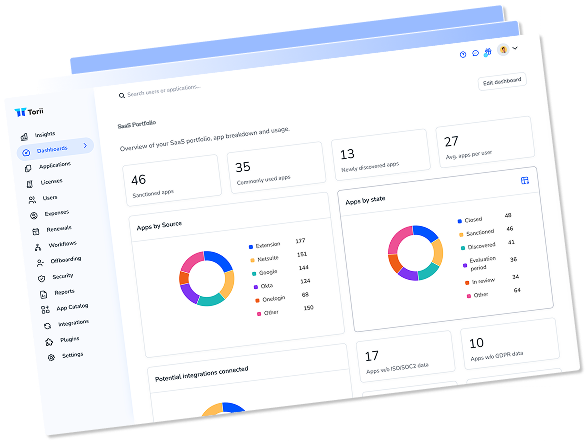In our digital age, businesses are piling on more and more Software as a Service (SaaS) apps. These cloud-based tools are flexible, scalable, and super convenient, making them a hit with companies big and small. But with more apps come more headaches. That’s where SaaS Management Platforms (SMPs) step in, making it easy to keep everything under control.
What is a SaaS Management Platform?
Note: You can read more about SMPs in this explainer.
A SaaS Management Platform helps companies discover, manage, and optimize all their cloud apps, both sanctioned and unsanctioned. It boosts security, cuts unnecessary costs, and automates tedious tasks. SMPs are the only technology able to manage all cloud apps because they are the only tools that can discover all these apps in the first place.
Get a complimentary copy of the 2024 Gartner® Magic Quadrant™ for SaaS Management Platforms.
Do We Really Need an SMP?
If you have SaaS, you need to manage it. The question is, can you manage it without an SMP?
Let’s look at the numbers. According to our SaaS Benchmarks Report:
- The average company has approximately 600 apps in their ecosystem
- Even amongst organizations with less than 100 employees, the average was 324 apps
- The majority of those apps are shadow IT
- Approximately 66% of those are idle
- Many apps have a license non-utilization rate of 30% or more
Those numbers are only visible through the use of a SaaS Management Platform like Torii. But let’s go further, what about future market trends?
According to the Gartner Magic Quadrant:
- Through 2027, organizations that fail to centrally manage SaaS life cycles will remain five times more susceptible to a cyber incident or data loss due to incomplete visibility into SaaS usage and configuration.
- Through 2027, organizations that fail to attain centralized visibility and coordinate SaaS life cycles will overspend on SaaS by at least 25% due to unused entitlements and unnecessary, overlapping tools.
- Through 2027, over 50% of organizations will centralize SaaS application management using an SMP, an increase from less than 10% in 2024.
SMPs help businesses manage their SaaS applications from one central place. These tools are essential. They help companies deal with issues like overspending, security risks, lack of visibility, and contract management.
Without SMPs, businesses face serious risks. Gartner predicts that by 2027, companies that don’t manage their SaaS apps centrally will be five times more likely to suffer a cyber incident or data loss. This happens because they can’t see or control all the SaaS apps being used. Without this visibility, companies are open to data breaches and other security threats.
Financially, the stakes are also high. Gartner says that without SMPs, companies will overspend on SaaS by at least 25% due to unused licenses and overlapping tools. This is because they lack efficient license management and a clear strategy for buying and using SaaS apps. Gartner also estimates that “per-employee SaaS spend currently averages $1,370, a 55% increase since 2021 (12% CAGR).”
Given these challenges, SMPs aren’t just optional—they’re necessary. They help companies make the most of their SaaS investments, improve security, and streamline operations. Next, we’ll look at how businesses use SMPs and the key features these platforms offer.
Which SaaS Management Platform is Right for Us?
Different platforms have different strengths and weaknesses. But, according to Gartner, you should look for a platform with the following capabilities. Gartner divides the list into three groups—must-have, standard, and option. Based on our understanding, you can think of the three groups in the following way:
- Must-Have Capabilities: Basically, if the platform does not include these capabilities, it is not an SMP. It might still be a useful tool, but it will not provide holistic visibility or management of your app ecosystem.
- Standard Capabilities: These are capabilities that we believe are standard across all of the 15 platforms evaluated by Gartner.
- Optional Capabilities: These are the capabilities that some platforms offer. It is up to the discretion of the buyer to determine how important any given feature/capability is for their situation.
Our Understanding of “Must-Have Capabilities” for SMPs
To effectively manage the complex world of SaaS, a good SaaS Management Platform (SMP) needs to have several key features. These features help organizations keep their SaaS applications secure, compliant, and running smoothly. Here are the essential features of a comprehensive SMP:
Discovery of All SaaS Apps: According to Gartner, “The ability to discover authorized and unauthorized SaaS usage via browser extension, device agent, financial/expense systems integration, security tool integration (including but not limited to SASE, SSE, CASB, SIEM, SWG, firewall and EDR), SSO and IDP platform integration, endpoint management tool integration, email system integration or direct API integration with SaaS applications.”
We believe it’s impossible to overstate the importance of discovery. Not only does it give you insight into your software ecosystem, but that information is what makes every subsequent capability worthwhile.. An SMP excels at this by weaving together insights from a variety of sources to get a panoramic view of a company’s software ecosystem—both sanctioned and unsanctioned—making it possible to manage and optimize every aspect of software usage with precision and confidence.
Automated Workflows for On/Offboarding: According to Gartner, “An automated workflow capability, including the ability to automate employee onboarding and offboarding for SaaS applications.”
We believe that the automation capability within SMPs is unique due to the data and insight pulled via the discovery process. No other system has access to the breadth and depth of SaaS data as an SMP. As such, automation is about improving, not just efficiency, but security as well. Onboarding and offboarding are important, but they are just the start of what an SMP can do.
Optimizing SaaS Expenses: According to Gartner, “The ability to optimize SaaS-related expenses, including the ability to identify redundant applications, identify and reallocate unused licenses, optimize usage, forecast SaaS expenses and assign ownership of applications to business owners outside of IT with role-based access controls.”
We believe that optimizing SaaS expenses is where SMPs truly shine, transforming cost management from a daunting task into a strategic advantage. For IT in particular, cost saving capabilities are the most visible advantages of an SMP. We believe that with an SMP, organizations can fight back against perceptions of IT as a cost-center and drive more visibility within the company.
Direct Management via API Integration: According to Gartner, “The ability to directly manage common SaaS applications from the SMP via read/write API integration.”
We believe that without API integrations, SaaS Management is just another tool. The read/write integrations with other applications differentiates a tool from a platform. This streamlined approach simplifies oversight and ensures consistent policy application across your entire SaaS landscape.
Standard Capabilities
According to Gartner, the Standard Capabilities include:
- “A platform compliant with applicable regulatory requirements, such as GDPR and CCPA/CPRA.”
- “ITSM integration, including ticketing, service catalog, self-service and CMDB.”
- “Extensibility via APIs, integrations, as well as providing capability for data import and export.”
- “An employee self-service SaaS application catalog, including a high number of direct SaaS application integrations.”
Optional Capabilities
While essential features are crucial for a SaaS Management Platform (SMP), we believe there are several optional features that can add extra value. These features give more control, insights, and efficiency, allowing organizations to customize the platform to their specific needs.
According to Gartner, the Optional Capabilities include:
- “Providing risk and compliance ratings for discovered apps, including applicable certifications.”
- “Pricing and adoption benchmarking reports.”
- “Vendor and contract management capabilities.”
- “GenAI integration for admins.”
- “Application request form and process for employees to request SaaS applications.”
Conclusion
Do you need an SMP?
If you have cloud applications and you prioritize the security, spend, visibility, optimization, and operationalization of those applications. Then, yes. An SMP is the only platform that provides the critical capabilities you need to protect and optimize these resources. They help secure data, cut unnecessary costs, and streamline operations, making them indispensable for modern IT environments. For us, the Gartner Magic Quadrant underscores the importance of SMPs, predicting significant financial and security risks for companies that do not implement these tools. For a deeper understanding of SMP capabilities and to ensure your organization stays ahead, we recommend reading the Gartner Magic Quadrant for SaaS Management Platforms.
Gartner, Magic Quadrant for SaaS Management Platforms, Tom Cipolla, Yolanda Harris, Jaswant Kalay, Dan Wilson, Ron Blair, Lina Al Dana, 22 July 2024
GARTNER is a registered trademark and service mark of Gartner, Inc. and/or its affiliates in the U.S. and internationally, and MAGIC QUADRANT is a registered trademark of Gartner, Inc. and/or its affiliates and are used herein with permission. All rights reserved.
Gartner does not endorse any vendor, product or service depicted in its research publications, and does not advise technology users to select only those vendors with the highest ratings or other designation. Gartner research publications consist of the opinions of Gartner’s research organization and should not be construed as statements of fact. Gartner disclaims all warranties, expressed or implied, with respect to this research, including any warranties of merchantability or fitness for a particular purpose.

